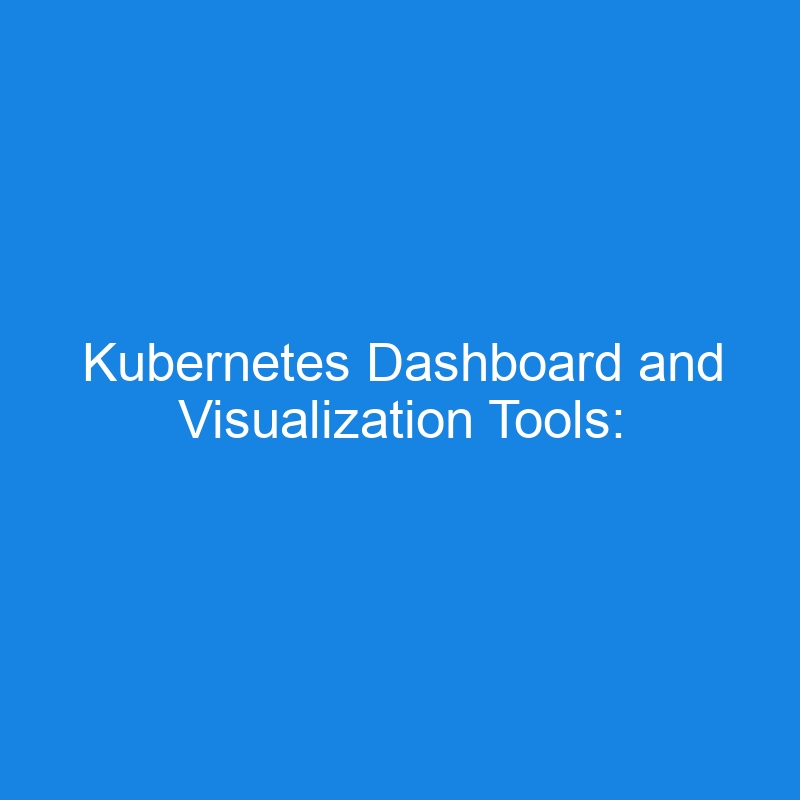Kubernetes Dashboard and Visualization Tools
Managing and monitoring a Kubernetes cluster can be challenging without proper tools. Kubernetes Dashboard and various third-party visualization tools make it easier to interact with, monitor, and debug cluster resources effectively.
In this article, we’ll explore the Kubernetes Dashboard, its features, setup, and some popular third-party visualization tools.
Kubernetes Dashboard
The Kubernetes Dashboard is a web-based UI that provides a visual interface to manage and monitor Kubernetes clusters. It allows users to view and control workloads, services, and cluster resources.
Key Features
- Workload Management: View and manage Deployments, ReplicaSets, Pods, and more.
- Service Discovery: Monitor Services, Ingress, and networking configurations.
- Namespace Management: Switch between namespaces to view resources.
- Resource Metrics: View CPU and memory usage for Pods and nodes (requires metrics server).
- Secrets and ConfigMaps: Securely manage configuration data.
- Interactive Shell: Access Pods via an interactive terminal.
Setting Up Kubernetes Dashboard
1. Install the Kubernetes Dashboard
Deploy the Dashboard using the official YAML manifest:
kubectl apply -f https://raw.githubusercontent.com/kubernetes/dashboard/v2.7.0/aio/deploy/recommended.yaml
2. Access the Dashboard
Expose the Dashboard using kubectl proxy:
kubectl proxy
Access the Dashboard at:
http://localhost:8001/api/v1/namespaces/kubernetes-dashboard/services/https:kubernetes-dashboard:/proxy/
3. Create a Service Account for Access
Create a Service Account with appropriate permissions for Dashboard access.
Example: Admin User Service Account
apiVersion: v1
kind: ServiceAccount
metadata:
name: admin-user
namespace: kubernetes-dashboard
---
apiVersion: rbac.authorization.k8s.io/v1
kind: ClusterRoleBinding
metadata:
name: admin-user-binding
roleRef:
kind: ClusterRole
name: cluster-admin
apiGroup: rbac.authorization.k8s.io
subjects:
- kind: ServiceAccount
name: admin-user
namespace: kubernetes-dashboard
Apply the configuration:
kubectl apply -f admin-user.yaml
Retrieve the authentication token:
kubectl -n kubernetes-dashboard create token admin-user
Use this token to log in to the Dashboard.
Popular Kubernetes Visualization Tools
1. Lens (Kubernetes IDE)
- Description: Lens is an open-source Kubernetes IDE that simplifies cluster management with a graphical interface.
-
Features:
- Cluster inspection and monitoring.
- Integrated terminal for running
kubectlcommands. - Visualization of workloads, networking, and storage.
-
Installation: Get Lens
2. K9s
- Description: A terminal-based UI for managing Kubernetes clusters.
-
Features:
- Real-time resource monitoring.
- Lightweight and fast for power users.
- Command-line integration with
kubectl.
-
Installation:
brew install k9s
3. Prometheus and Grafana
- Description: Prometheus is a monitoring and alerting toolkit, and Grafana is used to visualize metrics.
-
Features:
- Custom dashboards for resource metrics.
- Real-time alerts.
- Visualizations of cluster performance and trends.
-
Setup: Use Helm to deploy Prometheus and Grafana in your cluster:
helm install prometheus prometheus-community/kube-prometheus-stack
4. Octant
- Description: Octant is an open-source Kubernetes dashboard tailored for developers.
-
Features:
- Context-aware views of cluster resources.
- Resource visualizations and relationships.
- Plug-in architecture for extensibility.
-
Installation:
brew install octant
5. Kubebox
- Description: A terminal-based dashboard for Kubernetes and monitoring tools.
-
Features:
- Real-time Pod and node metrics.
- Cluster-wide logs and resource usage.
- Compatibility with Prometheus metrics.
Best Practices for Using Visualization Tools
-
Secure Access:
- Use Role-Based Access Control (RBAC) to restrict access to sensitive resources.
- Enable HTTPS for web-based tools to secure communication.
-
Monitor Metrics:
- Set up a metrics server to enhance the visualization of resource usage in tools like the Kubernetes Dashboard.
-
Integrate Alerts:
- Use tools like Prometheus Alertmanager to notify administrators of cluster issues.
-
Regular Audits:
- Periodically review permissions and access configurations for these tools.
-
Combine Tools:
- Use a combination of tools like Lens, Prometheus, and Grafana to cover different aspects of cluster management.
Conclusion
Kubernetes Dashboard and visualization tools simplify cluster management and provide critical insights into resource usage and application performance. By leveraging these tools, administrators and developers can efficiently manage workloads, troubleshoot issues, and optimize resource utilization.
Select tools based on your team’s requirements, and ensure they are configured securely to protect your Kubernetes environment.
